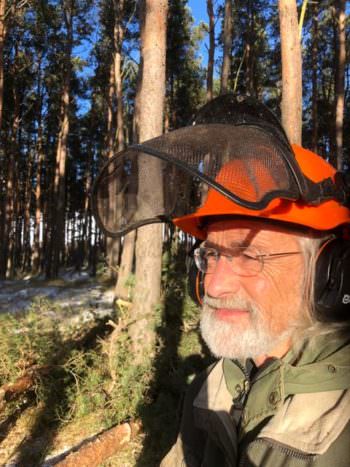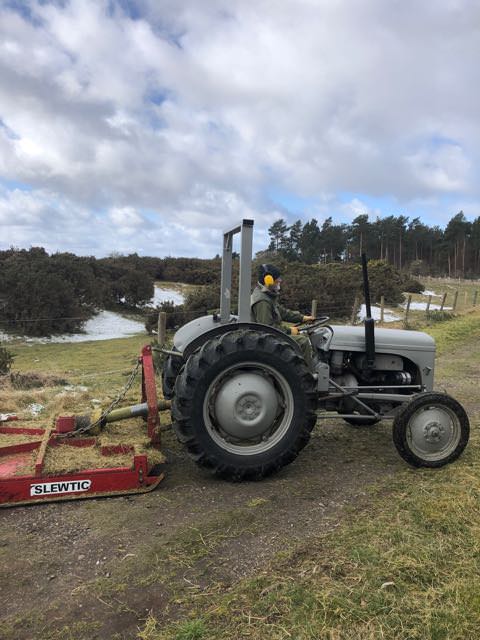 By Kajedo Wanderer
By Kajedo Wanderer
While much of the life on the land is hibernating, winter is a busy season for those of us working on the land.
Last winter we cleared the first three ‘islands’ of trees (roughly circular open spaces surrounded by the tall pines), planted 40% oaks, scarified (opened) the ground in preparation for natural regeneration of the surrounding scot’s pines. Now with three more ‘islands’ cleared this winter, the long timbers pulled out and the firewood stacked, the ground was ‘scarified’ (opened) for easier seeding and oaks were planted.
Another big project on our felling plan was clearing the site where we intend to build the new ‘Conservation Hub’ and thinning out the nearby Corsican Pines for milled timber – walls and floors of the building. Some 60 trees were felled and cut to size there. We pulled the timbers out with our tractor and stripped the bark off the intended post, beams and rafters for the new building. The timbers are ready – now we just need to complete our fundraising!
To the casual observer it isn’t always obvious why we cut down some trees while leaving others. But in our small woodland our fragile red squirrel population needs protecting – and it isn’t always easy to spot their drays (nests). We don’t cut trees with squirrel drays in them, nor those immediately surrounding them. There are also nests of birds which some of them return to year after year – those too we are trying to protect.
It was a busy season – albeit quiet on the people front. Due to Covid restrictions gatherings at the Hinterland shelter were limited – it was delightful to hear Taize singing coming from the shelter on some Sunday mornings, while the restrictions were eased somewhat. But during lockdown volunteer work was restricted to very small numbers coming out for ‘green gym’ – stacking wood in the forest, or for stripping bark off our timbers.
A few people came out to help progress the cob-wall building in the Outdoor Learning Space in the Edible Woodland Garden. We could not easily run our Saturday work parties and had no other groups on the land. However, probably also due to Covid there were significantly more people on our paths & tracks out for walks, runs or cycling. Getting some exercise and enjoying the natural environment, breathing some fresh air. It was delightful to see the little three year old kids (‘Findhorn Sprouts” with their carers in the woods and at the shelter on a regular basis.
This year we are organising four ‘Wild Camping Retreats’, starting on the first weekend in June; and ‘Out of the Ashes & Out of the Sand’ a week-long camping retreat in August. This title has new relevance after the recent tragic fires in the Park, resulting in the loss of the Community Centre and Main Sanctuary.
Now that spring has arrived (though unusually cold) our activities are changing and we are seeing an increase in bookings of the Hinterland Shelter (HS) area. The ‘Northern Lights Sangha’ have been meditating there quite frequently on Saturday mornings.
We are looking forward to welcoming work-parties again and to resuming our tours of the land.
It was great to see around eight children with their parents learning about trees as they helped plant some 35 saplings in the recently cleared SE corner of the woods.
We have completed our annual ‘topper work’ – cutting the gorse on firebreaks, paths, tracks, the Green Burial area and around the wind turbines. The ‘topper’ is then followed by the brushcutter which does the same work in the places the topper can’t reach – such as the slopes of Lyle’s wood. The ‘gorse cutting’ theme will continue well into the summer – pushing back invading gorse on Dune’s Heath and the lichen beds with loppers and handsaws. This time of the year it means working along the edges of a sea of coconut-scented yellow blossoms !
On a personal note, like many others in the Findhorn Foundation I have recently been made redundant. For the last five years I had been seconded to the FHT and, thankfully, in July the FHT will employ me half-time. Looking at the long term sustainability of our care for the land, I feel it is a good decision for the FHT to create its own position for a land manager.
In these strange and uncertain times many people, all over the world, are finding refuge and solace in the company of trees, in the uplifting, healing gifts of wilder nature around us.
With gratitude for this unique, beautiful piece of land in our care.
Yours in community,
Kajedo Wanderer
FHT Land Manager


















FHT Land Management Winter/Spring 2020/21
While much of the life on the land is hibernating, winter is a busy season for those of us working on the land.
Last winter we cleared the first three ‘islands’ of trees (roughly circular open spaces surrounded by the tall pines), planted 40% oaks, scarified (opened) the ground in preparation for natural regeneration of the surrounding scot’s pines. Now with three more ‘islands’ cleared this winter, the long timbers pulled out and the firewood stacked, the ground was ‘scarified’ (opened) for easier seeding and oaks were planted.
Another big project on our felling plan was clearing the site where we intend to build the new ‘Conservation Hub’ and thinning out the nearby Corsican Pines for milled timber – walls and floors of the building. Some 60 trees were felled and cut to size there. We pulled the timbers out with our tractor and stripped the bark off the intended post, beams and rafters for the new building. The timbers are ready – now we just need to complete our fundraising!
To the casual observer it isn’t always obvious why we cut down some trees while leaving others. But in our small woodland our fragile red squirrel population needs protecting – and it isn’t always easy to spot their drays (nests). We don’t cut trees with squirrel drays in them, nor those immediately surrounding them. There are also nests of birds which some of them return to year after year – those too we are trying to protect.
It was a busy season – albeit quiet on the people front. Due to Covid restrictions gatherings at the Hinterland shelter were limited – it was delightful to hear Taize singing coming from the shelter on some Sunday mornings, while the restrictions were eased somewhat. But during lockdown volunteer work was restricted to very small numbers coming out for ‘green gym’ – stacking wood in the forest, or for stripping bark off our timbers.
A few people came out to help progress the cob-wall building in the Outdoor Learning Space in the Edible Woodland Garden. We could not easily run our Saturday work parties and had no other groups on the land. However, probably also due to Covid there were significantly more people on our paths & tracks out for walks, runs or cycling. Getting some exercise and enjoying the natural environment, breathing some fresh air. It was delightful to see the little three year old kids (‘Findhorn Sprouts” with their carers in the woods and at the shelter on a regular basis.
This year we are organising four ‘Wild Camping Retreats’, starting on the first weekend in June; and ‘Out of the Ashes & Out of the Sand’ a week-long camping retreat in August. This title has new relevance after the recent tragic fires in the Park, resulting in the loss of the Community Centre and Main Sanctuary.
Now that spring has arrived (though unusually cold) our activities are changing and we are seeing an increase in bookings of the Hinterland Shelter (HS) area. The ‘Northern Lights Sangha’ have been meditating there quite frequently on Saturday mornings.
We are looking forward to welcoming work-parties again and to resuming our tours of the land.
It was great to see around eight children with their parents learning about trees as they helped plant some 35 saplings in the recently cleared SE corner of the woods.
We have completed our annual ‘topper work’ – cutting the gorse on firebreaks, paths, tracks, the Green Burial area and around the wind turbines. The ‘topper’ is then followed by the brushcutter which does the same work in the places the topper can’t reach – such as the slopes of Lyle’s wood. The ‘gorse cutting’ theme will continue well into the summer – pushing back invading gorse on Dune’s Heath and the lichen beds with loppers and handsaws. This time of the year it means working along the edges of a sea of coconut-scented yellow blossoms !
On a personal note, like many others in the Findhorn Foundation I have recently been made redundant. For the last five years I had been seconded to the FHT and, thankfully, in July the FHT will employ me half-time. Looking at the long term sustainability of our care for the land, I feel it is a good decision for the FHT to create its own position for a land manager.
In these strange and uncertain times many people, all over the world, are finding refuge and solace in the company of trees, in the uplifting, healing gifts of wilder nature around us.
With gratitude for this unique, beautiful piece of land in our care.
Yours in community,
Kajedo Wanderer
FHT Land Manager